#new archaeology
Explore tagged Tumblr posts
Text
What happened in archaeology during the 20th century? - Part 2
As mentioned in the previous article, during the time before 1960 in the 20th century, the focus was on methodological improvements in archaeology. From 1960 on, the focus was on theoretical improvements in archaeology. This does not mean that the 1960s marked a clear line between methodological and theoretical development in archaeology. This means the majority of events and concerns in the discipline were slightly different before and after 1960.
What happened in archaeology after 1960s?
From 1960 on, archaeology transformed into a new version of itself. We refer to it as “New Archaeology”. So, the birth of new archaeology is the main thing that happened in archaeology after 1960.
What is New Archaeology?
In new archaeology, the main focus is on studying the cultural processes of past human societies. As you may remember, in the background era of archaeology, the focus was to discover the legendary cities of the past. In the Renaissance era, the focus was to collect antiquities and study the history of antiquity. Then, in the 19th century, the focus was on studying the history of humans and their culture. Again, in the 20th century before 1960, the focus was the same. Then, only after 1960, scholars started to study how human cultures were born, evolved, and changed.
In simple words, before this new archaeology, what archaeologists studied were random and independent events in the past related to humans. But with new archaeology, they studied how those events in history connected with each other. They studied how both intentional and accidental acts of human ancestors have shaped their culture. How did the things that past humans did as well as the things that happened to past humans shape the cultures of past humans? They examined. So, as archaeologists focused on this process of birth and evolution of cultures, we call this processual archaeology.
Read full article on New Archaeology: Processual Archaeology at kamalsjournal.com
Other than the birth of New Archaeology, there were a few important events and trends that occurred after the 1960s, as listed below:
Scholars like Lewis Binford introduced new theories that resulted the emergence of new archaeology
Gordon Childe had introduced his theory of the Neolithic Revolution, explaining how human ancestors domesticated animals and plants. He said that after the domestication of animals and plants, establishing settlements and making pottery took place in order. Archaeology became the scientific discipline to test these theories.
The extensive use of technology to analyse and interpret data
Studies transformed into problem-oriented studies. Scholars began to conduct studies to find answers to research questions.
The studies focused on providing more rational conclusions than ever.
Archaeologists introduced Rescue archaeology, or salvage archaeology, to save archaeological monuments and sites as warfare and development projects were causing huge destruction to them Soon, Archaeological Impact assessments became a necessity before development projects.
In 1970, scholars introduced cultural resource management to protect valuable archaeological sites and monuments. Then, they introduced archaeological heritage management and cultural heritage management too.
So, the new archaeology is an upgrade of archaeology that emerged in the 1960s with better theories and methods, focusing on studying the cultural processes of the human past through material data.
What Happened in Archaeology After 1980?
After 1980, the new archaeology was questioned, and a new version emerged, named post-processual archaeology. Scholars like Ian Hodder introduced new theories for archaeology. This age was literally a period of theoretical reform in archaeology. In order to understand archaeology in this age, the characteristics of new archaeology and post-processual archaeology can be compared.
The new archaeology focused on quantitative results. Post-processual archaeology focused on qualitative results.
The new archaeology was pessimistic. Post-processual archaeology was optimistic. In new archaeology, it was believed that past human cultures were never able to be reconstructed with the limited data found in archaeology. In post-processual archaeology, the approach was optimistic regarding the matter.
New archaeology focused on the processes that were behind creating antiquities. Post-processual archaeology focuses on the culture behind antiquities.
The new archaeology focused on explaining past landscapes as cultural processes. Post-processual archaeology focuses on cultural or cognitive aspects of past human beings.
New archaeology considered that past incidents happened that way because of external factors such as environmental conditions, and things only changed when the environment changed. But post-processual archaeology considers the choices made by humans in the formation of history.
New archaeology looked into the past from the same point of view as we look into the present. But post-processual archaeology looked at the past from different perspectives.
New archaeology tried to understand the past as patterns of social, economic, and political anomalies, but post-processual archaeology tries to understand the past as a collection of individual anomalies. As an example, in new archaeology, it will be said that the Stone Age is followed by the Bronze Age, and the Bronze Age is followed by the Iron Age as a pattern, with some minor exceptions, due to the nature of the impact from the environment. But, in post-processual archaeology, it will be specific with the place and time where and when the Stone Age was followed by which, either bronze, copper, or iron, considering the individuality of incidents and trends that occurred in the history of mankind due to the cognition of mankind, not the environment.
Read full article on Post-Processual Archaeology at kamalsjournal.com
Summary
As discussed above, the discipline of archaeology, which had already emerged in the 19th century, was developed further as a science in the 20th century. In the first six decades of the 20th century, the use of technology extensively developed archaeology as a science in practical ways, such as chemical dating methods.
Then, in the 1960s, the theoretical evolution of archaeology took place. Rather than explaining the story behind antiquities, the past human cultural process was studied with the use of antiquities, marking the first origin of the form of archaeology we have today, which is ‘studying through material data’. And also, archaeological heritage management was introduced to have standards for dealing with archaeologically important heritage.
Then, in the 1980s, with post-processual archaeology, the approach to archaeological studies changed. Earlier, mankind’s cognition was neglected when recreating the past through material remains. There, the environment was considered the force of evolution. Simply put, it said that human culture had changed due to environmental changes. But, in post-processual archaeology, it was said that human culture changed mainly due to the intelligence humans had. As humans, we could choose whatever we wanted with our intelligence. Further, it emphasised that the past is not a pattern but a collection of various occurrences that happened at various times and in various places individually.
As of today, the archaeology we refer to is this post-processual archaeology. So, this is the long process of the origin of archaeology. However, there is an ongoing, never-ending debate about processual archaeology vs. post-processual archaeology.
At this point, if you read all seven articles, I am sure you probably get the same image in your head as I do when I hear “History of Archaeology”. And now, most probably, you have your own idea of the origin of archaeology too.
#archaeoblr#archaeology#archaeologist#archaeology for all#archaeology student#origin of archaeology#history of archaeology#20th century archaeology#archaeology in the 20th century#archaeology in the 60s#archaeology in the 80s#new archaeology#processual archaeology#post-processual archaeology#kamalsjournal#chanakakamal#empowering curiosity#inspiring understanding#sharing knowledge#academic blog
2 notes
·
View notes
Text

Gold swivel ring featuring an amethyst frog, from the New Kingdom period of Egypt, dating between 1550-1229 BC.
#new kingdom#ancient egypt#egyptology#egyptian#egypt#frog art#frog#amethyst#purple and gold#gold jewelry#gold rings#egyptian history#egyptian archaeology#egyptian art#antique#antiquities#toya's tales#style#toyastales#toyas tales#art#ring#antique jewelry#world history#artifact#art history#swivel ring#amphibians#fashion#accessories
3K notes
·
View notes
Text
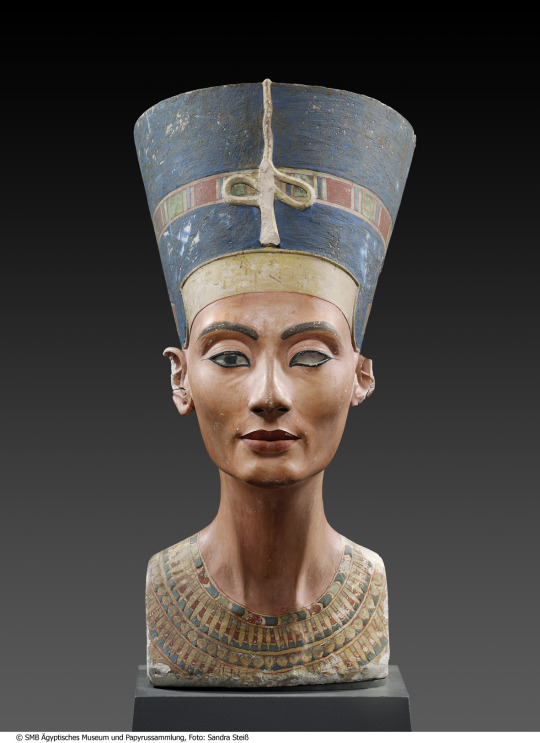
~ Bust of Queen Nefertiti.
Period: 18th Dynasty, New Kingdom; reign of Amenhotep IV/Akhenaten
Medium: Limestone, painted; stucco; beeswax, black; rock crystal.
#ancient#ancient art#history#museum#archeology#ancient egypt#ancient sculpture#ancient history#archaeology#egypt#egyptian#egyptology#Nefertiti#new kingdom#18th Dynasty#Amenhotep IV#Akhenaten
1K notes
·
View notes
Text
HELLO HI YES I AM CURRENTLY GOING INSANE OVER THE NYCC SW BOOKS PANEL BECAUSE LOOK AT PRETTY JEDI ARMOR




THE IMPLICATIONS THAT THE JEDI TEMPLE GUARD ARMOR ARE SOME OF THE LAST LIVING STYLISTIC REMNANTS OF THE HIGH REPUBLIC. THE (fully my assumptions ahead) POSSIBILITY THAT THE ARMOR IS PASSED DOWN FROM THE ERA OF FIGHTING AGAINST THE SITH. I WILL BE CHEWING ON THE WALLS UNTIL WE GET CONTEXT AND BACKSTORY FOR THIS.
#sorry i am weird and intense about star wars anthropology and archaeology crawling around zeffo ruins in jfo rewired parts of my brain#K8 Rambles about Star Wars#K8 Rambles about The High Republic#LOOK AT MY TRAUMATIZED ARMORED JEDI BABIES#star wars#star wars books#star wars the high republic#sw the high republic#sw thr#avar kriss#elzar mann#burryaga agaburry#bell zettifar#new york comic con#nycc 2024#nycc
1K notes
·
View notes
Text
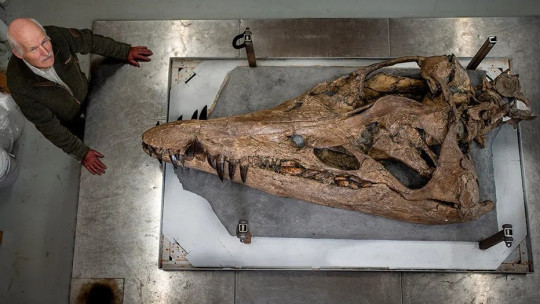
Gigantic Skull of Prehistoric Sea Monster Found on England’s ‘Jurassic Coast’
The remarkably well-preserved skull of a gigantic pliosaur, a prehistoric sea monster, has been discovered on a beach in the county of Dorset in southern England, and it could reveal secrets about these awe-inspiring creatures.
Pliosaurs dominated the oceans at a time when dinosaurs roamed the land. The unearthed fossil is about 150 million years old, almost 3 million years younger than any other pliosaur find. Researchers are analyzing the specimen to determine whether it could even be a species new to science.
Originally spotted in spring 2022, the fossil, along with its complicated excavation and ongoing scientific investigation, are now detailed in the upcoming BBC documentary “Attenborough and the Jurassic Sea Monster,” presented by legendary naturalist Sir David Attenborough, that will air February 14 on PBS.

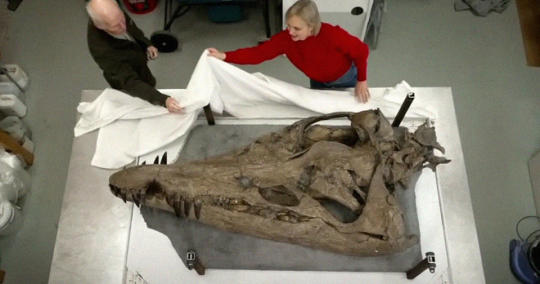
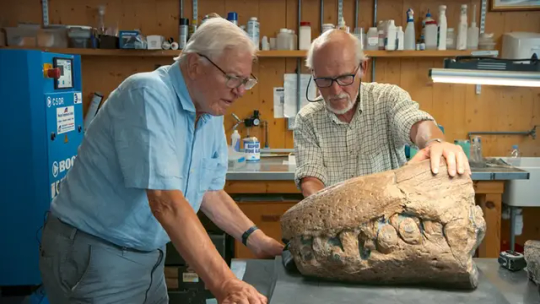
Such was the enormous size of the carnivorous marine reptile that the skull, excavated from a cliff along Dorset’s “Jurassic Coast,” is almost 2 meters (6.6 feet) long. In its fossilized form, the specimen weighs over half a metric ton. Pliosaurs species could grow to 15 meters (50 feet) in length, according to Encyclopaedia Britannica.
The fossil was buried deep in the cliff, about 11 meters (36 feet) above the ground and 15 meters (49 feet) down the cliff, local paleontologist Steve Etches, who helped uncover it, said in a video call.
Extracting it proved a perilous task, one fraught with danger as a crew raced against the clock during a window of good weather before summer storms closed in and the cliff eroded, possibly taking the rare and significant fossil with it.
Etches first learned of the fossil’s existence when his friend Philip Jacobs called him after coming across the pliosaur’s snout on the beach. Right from the start, they were “quite excited, because its jaws closed together which indicates (the fossil) is complete,” Etches said.
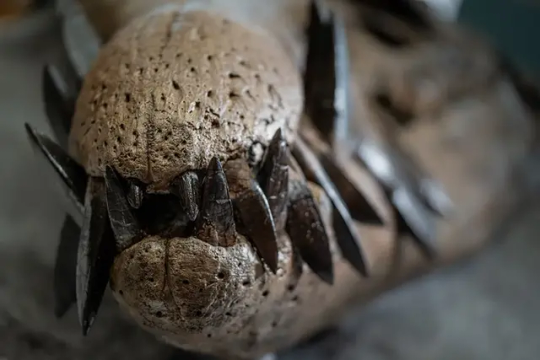
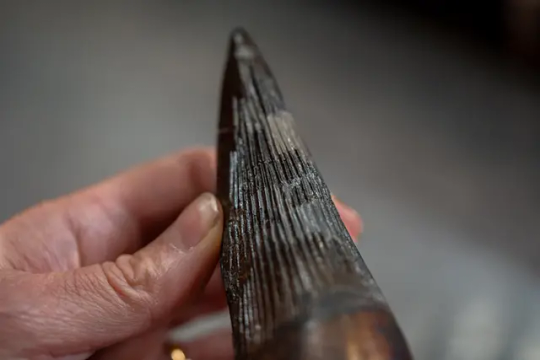
After using drones to map the cliff and identify the rest of the pliosaur’s precise position, Etches and his team embarked on a three-week operation, chiseling into the cliff while suspended in midair.
“It’s a miracle we got it out,” he said, “because we had one last day to get this thing out, which we did at 9:30 p.m.”
Etches took on the task of painstakingly restoring the skull. There was a time he found “very disillusioning” as the mud, and bone, had cracked, but “over the following days and weeks, it was a case of …, like a jigsaw, putting it all back. It took a long time but every bit of bone we got back in.”
It’s a “freak of nature” that this fossil remains in such good condition, Etches added. “It died in the right environment, there was a lot of sedimentation … so when it died and went down to the seafloor, it got buried quite quickly.”

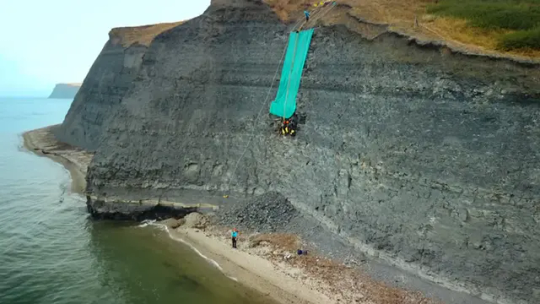
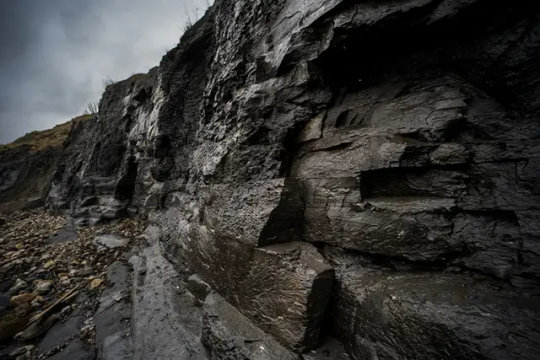
Fearsome top predator of the seas
The nearly intact fossil illuminates the characteristics that made the pliosaur a truly fearsome predator, hunting prey such as the dolphinlike ichthyosaur. The apex predator with huge razor-sharp teeth used a variety of senses, including sensory pits still visible on its skull that may have allowed it to detect changes in water pressure, according to the documentary.
The pliosaur had a bite twice as powerful as a saltwater crocodile, which has the world’s most powerful jaws today, according to Emily Rayfield, a professor of paleobiology at the University of Bristol in the United Kingdom who appeared in the documentary. The prehistoric marine predator would have been able to cut into a car, she said.
Andre Rowe, a postdoctoral research associate of paleobiology at the University of Bristol, added that “the animal would have been so massive that I think it would have been able to prey effectively on anything that was unfortunate enough to be in its space.”
By Issy Ronald.


#Gigantic Skull of Prehistoric Sea Monster Found on England’s ‘Jurassic Coast’#Dorset England#pliosaur#jurassic#fossil#prehistoric#dinosaur#paleobiology#palaeontologists#archaeology#archeolgst#history#history news#ancient history#Sir David Attenborough#nature#naturalist
2K notes
·
View notes
Text







Jorba Castle Works, Puig de la Guàrdia, Spain - Carles Enrich
#Carles Enrich#architecture#design#building#modern architecture#modern#minimal#old and new#history#ruin#old building#historical#historical sites#castle#shelter#archaeology#spain#spanish architecture#cool design#beautiful places#landscape#slopes#timber#wood architecture#timber frame#joinery#polycarbonate#lightweight#architectural photography#stone
226 notes
·
View notes
Text
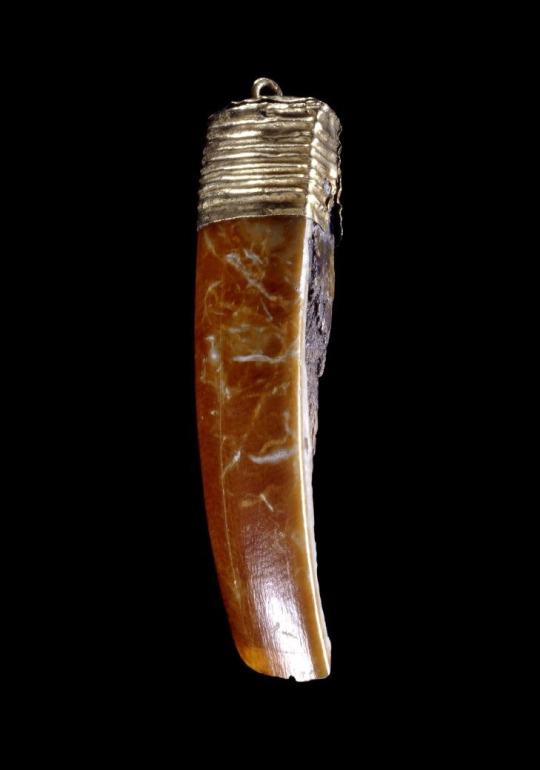
An Anglo-Saxon beaver tooth amulet discovered at the Wigber Low burial site in Derbyshire.
A 6th-century Anglo-Saxon riddle describes the beaver:
I am a dweller on the edge of steep stream banks, and not lazy at all, but warlike with the weapons of my mouth.
I sustain my life with hard labour, laying low huge trees with my hooked axes.
I dive into water, where the fish swim, and immerse my own head, wetting it in the watery surge.
The wounds of sinews and limbs foul of gore I can cure. I destroy pestilence and the deadly plague. I eat the bitter and well-gnawed bark of trees.
The Eurasian Beaver was hunted to extinction in Britain by the 16th century; since 2009, there has been an ongoing project to reintroduce them in Scotland.
#no idea there'd ever been beaver in Europe#no wonder they were so stoked to find more to kill in the New World#shiny objects#anglo-saxons#archaeology
561 notes
·
View notes
Text

Bust of a Pharaoh Dating: Amenhotep IV / Akhenaten (18th Dynasty -> New Kingdom -> Egypt) Neues Museum, Berlin, Germany
#Amenhotep#Amenhotep IV#egypt#egyptian#art#bust#world history#18th dynasty#archaeology#Akhenaten#new kingdom#limestone#background blacked out
281 notes
·
View notes
Text
On 2 May 2024, the remains of an unidentified ship were uncovered on the north beach of Sable Island off the east coast of Canada. As the archaeologists have not yet finished their investigations, we do not yet know who this lady is or how old she is, but hopefully that will change soon.
Video by Zoe Lucas
#naval history#naval artifacts#shipwreck#2 may 2024#underwater archaeology#sable island#canada#age of sail#age of steam#new lady revealed
375 notes
·
View notes
Text
It has now been confirmed that the tomb found in 2022 is the tomb of Thutmose II
69 notes
·
View notes
Text

Taos Pueblo, New Mexico, circa 1880.
874 notes
·
View notes
Text
Heritage News of the Week
Discoveries!
The last missing tomb of a king from Ancient Egypt’s Eighteenth Dynasty, King Thutmose II, has been found by researchers, marking the first royal burial to be unearthed since the discovery of Tutankhamen in 1922.
Archaeologists may have found pharaoh's second tomb
A British archaeologist believes his team may have found a second tomb in Egypt belonging to King Thutmose II. The potential find comes just days after Piers Litherland announced the discovery of a tomb more than a century since Tutankhamun's was revealed. Mr Litherland told the Observer he suspects this second site will hold the pharaoh's mummified body. Archaeologists believe the first tomb was emptied six years after burial, due to a flood, and relocated to a second.

It's tombapalooza!
Archaeologists discover oldest section of China’s Great Wall, dating back nearly 3,000 years
A newly uncovered section of the Great Wall of China in the late Western Zhou Dynasty, dating back nearly 3,000 years, suggests the structure's origins are three centuries older than previously thought.
Shattered 1,800-year-old sword was 'ritually sacrificed' and may be from Vandal warrior's grave
Metal detectorists searching for World War II artifacts in a forest in Poland stumbled upon something far older: a nearly 2,000-year-old sword purposefully broken into three pieces. The weapon may have been a funeral offering for a fallen member of the Vandals, a Germanic tribe renowned for sacking Rome in the fifth century.
Rare discovery of two-handed medieval sword
The sword was discovered in a weapons deposit alongside two axe heads dating back to the 14th-15th century AD. Experts from the Ostróda Museum note that the sword is exceptionally well preserved, with its hilt, pommel, and guard fully intact.
When will it be my turn to find a sword
119-year-old bottle found behind crown above theatre stage
A theatre-lover was "astonished" to find a 119-year-old message in a bottle during a special behind-the-scenes tour of Edinburgh's King's Theatre.
Lasers reveal 1,000-year-old Indigenous road near Chaco Canyon that aligns with the winter solstice
Researchers say the road was part of an Indigenous ritual landscape, serving as a path between natural springs and aligning with the sunrise on the winter solstice, a new study finds.
Iron Age remains found in bog may have been sacrificial
Ancient human remains discovered in peatland in County Londonderry in 2023 are now thought to be those of a young woman who died more than two millennia ago.
2,000-year-old spoon from Isle of Man may have been used in blood rituals for fortune telling
A metal detectorist searching private land on the Isle of Man has uncovered a rare bronze spoon that experts believe may have been used by an Iron Age shaman to tell the future.
1,300-year-old royal flush toilet used by crown prince discovered at palace in Korea
Archaeologists in Korea have uncovered the remains of multiple flushing toilets within a 1,300-year-old palace complex. But there was one "throne" to rule them all: The crown prince got a special toilet that drained directly into a nearby river.
Brazilian navy confirms location of World War II shipwreck
After more than 80 years hidden beneath the waves off Rio de Janeiro, the location of a Brazilian troop transport ship torpedoed and sunk by Nazi Germany was definitively confirmed by Brazil’s navy this week.
Metal detectorists unearth 15th century coin hoard
The coins are a mix of Scottish and English coins, comprising English silver groats minted by Henry V (1413-1422) to Edward IV (1461-1483), and Scottish gold demy and half-demys of James I (1406-1437) and James II (1437-1460).
These metal detectorists behaved responsibly and called in the archaeologists!
Construction workers make unexpected discovery in Zakroczym
A construction team in Zakroczym, Poland, have uncovered a mysterious fountain shaped like a clover during works on the National Road No. 7 between Czosnów and Modlin.
Rare hair specimen hints at Scots ancestors' low vitamin D
A recent study by the University of Aberdeen has discovered present-day Scots could be just as deficient in vitamin D as their ancestors.
As someone with Scottish ancestry, I feel like this explains a lot.
Archaeologists revisit Baden-Baden’s Roman “Imperial Baths” after 180 Years
While recent sewer renovations were underway, archaeologists from ArchaeoConnect used the opportunity to examine newly exposed sections of the complex in an area of 50 square metres.
Małopolskie region reveals oldest evidence of metal mining in Poland, dating back 1,000 years earlier than previously thought
Researchers have uncovered the oldest confirmed evidence of metal ore mining and metallurgy in Poland through the study of lead artifacts from the Early Iron Age (800–500 BCE) sourced from the Olkusz deposits.
Oldest evidence of systematic stone blade production on the Arabian Peninsula
In a recent study, published in the journal Archaeological and Anthropological Science, new chronometric data indicates that the youngest Middle Palaeolithic layer at Jebel Faya (AH II) represents human occupation at the site around 80,000 years ago, near the end of the MIS 5 humid phase.
9,000-year-old rock art suggests early humans interacted with dinosaur footprints
In Brazil, researchers have made an extraordinary discovery of ancient rock art dating back over 9,000 years, found alongside dinosaur footprints from the Cretaceous Period, approximately 66 million years ago.
Prehistoric jewellery has cosmic origins
A study of prehistoric jewellery from the Częstochowa Museum collection has revealed meteoric iron in three bracelets.
Significant archaeological discovery on Failaka Island: Hellenistic courtyard and building unearthed
The excavation team uncovered rock foundations, an internal wall, and an entrance that connects the external courtyard to a room containing remnants of plastered walls and numerous pottery artifacts, all over 2,000 years old.
Viking Age skulls reveal widespread disease
A new study by the University of Gothenburg suggests that Sweden’s Viking Age population suffered from widespread disease.
Museums
The survey of independent cultural attractions found that three quarters of respondents were concerned for the future of the wider sector
British Museum appoints architect for major redevelopment
London’s British Museum has today announced that Lina Ghotmeh Architecture (LGA) has won the competition to redesign its Western Range galleries.
Struggling English museums get rescue funds
Museums, theatres and other cultural venues in England are to receive £270m funding to stay afloat and fix their crumbling buildings, the government has said.
Repatriation
The Netherlands has agreed to return 119 Benin Bronzes to Nigeria per the country’s request, marking the single largest return to date of Benin antiquities looted by the British military as part of its 1897 punitive expedition, as announced Wednesday, February 19.
Cleveland Museum of Art will return looted Greco-Roman bronze to Turkey
Scientific analysis confirmed that the ancient, headless sculpture had been looted from a shrine in Bubon
Heritage at risk
Following the fall of the Assad regime in December 2024, experts are turning their attention to the country’s war-torn heritage sites, hoping to restore these treasures and revive a tourism industry that could provide a much-needed economic boost.
Man vandalizes 500-year-old artifact in Peru, causing ‘irreversible damage’
The incident took place at 12:49 a.m. on February 19, when a man “apparently intoxicated and out of his mind, used a metal object to attack the stone element, causing stone fragments to fall, in six visible impacts on the emblematic stone structure,
Odds and ends
The all-female Forty Elephants lived by their own shoplifting and pickpocketing code. Now a new Disney+ series from the creator of Peaky Blinders tells the wild true story of the gang and its "queen", Mary Carr.
The illegal church at the heart of US history
In the heart of what was once Britain's largest colony in the New World, a "secret" church reveals how Black people lived and worshipped in the US's earliest days.
Baker needed stitches making prize-winning Tudor cake
Emma Jayne, 54, from Aberdare, Rhondda Cynon Taf, won Cake Artist of the Year at the D'licious Magazine Awards for her life-size cake of Queen Elizabeth I.

Why the Roman city of Pompeii in Italy still haunts and fascinates us
Pompeii’s ruins weren’t discovered until the 18th century. Their remarkable level of preservation and the subsequent discovery of human-shaped cavities in the ash there (and in nearby Herculaneum) seized the public’s imagination. Pompeii’s discovery rekindled a general interest in antiquity, a fascination that inspired arts, letters, and architecture.
Storms reveal huge dinosaur footprint on beach
Fossil guide Joe Thompson said the 130-million-year-old Iguanodon print at Shepherd's Chine was the best footprint he had ever found. The three-toed shape, which is almost 1m (3ft) across, was revealed after storms stripped the beach of shingle.
#YOU GET A TOMB! YOU GET A TOMB! EVERY! BODY! GETS! A! TOMB!#this is very exciting!#heritage news of the week#history#archaeology#museums#Egypt#paleontology#syria#gif
105 notes
·
View notes
Text
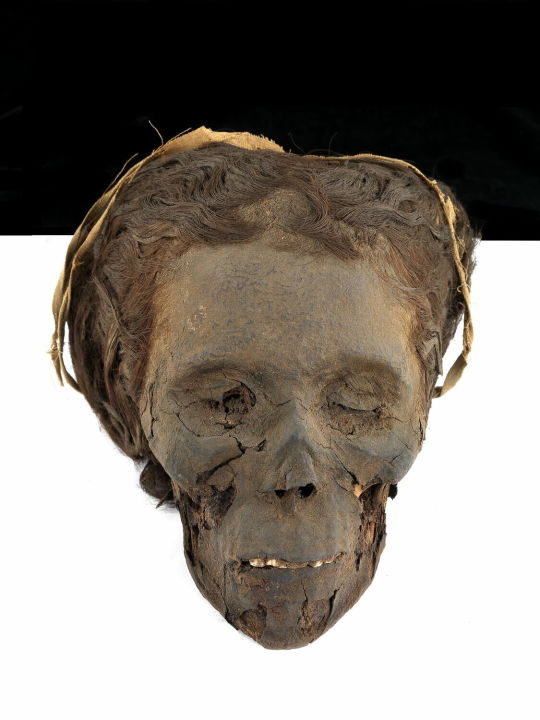



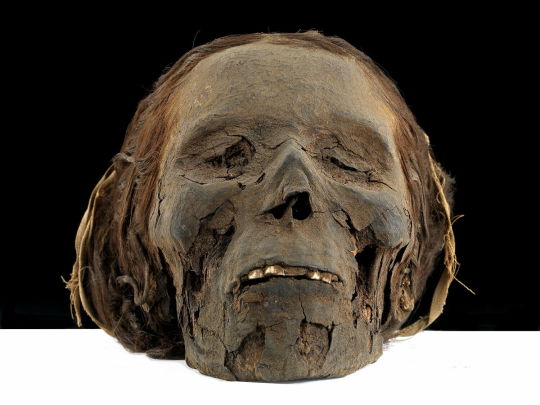
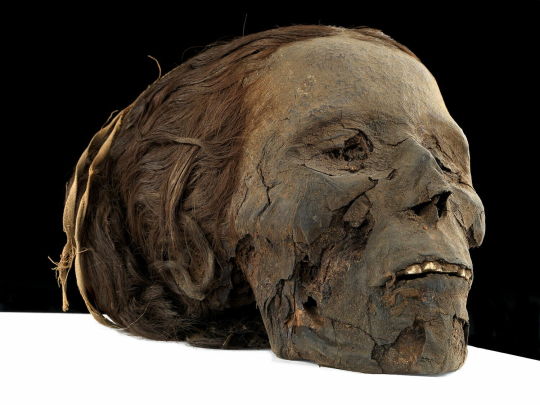
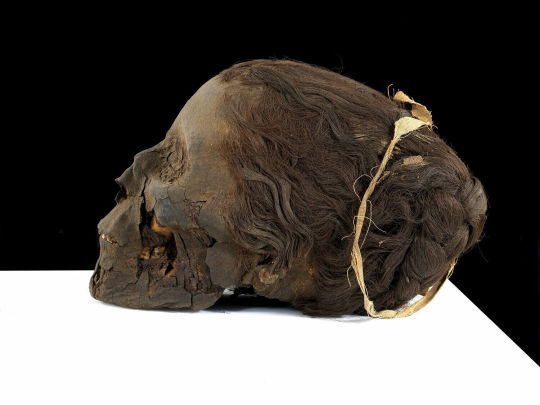
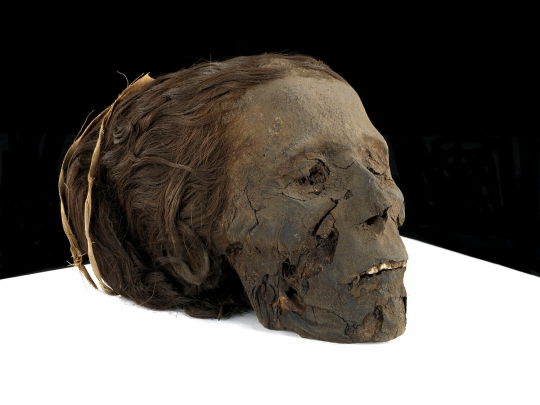
~ Woman Mummy.
Date: 1550-332 B.C.
Period: New Kingdom, Late Period
Medium: Organic; Secondary Medium: Resin, linen (?)
#ancient#ancient art#history#museum#archeology#ancient egypt#ancient history#archaeology#mummy#woman mummy#late period#1550 b.c.#332 b.c.#new kingdom#hair
1K notes
·
View notes
Text
Lost cities of the Amazon: how science is revealing ancient garden towns hidden in the rainforest
Archaeologists using 3D mapping are uncovering the remains of thousands of green metropolises with composted gardens, fisheries, and forests groomed into orchards

For decades, archaeologists have believed that human occupation of the Amazon basin was far older, vaster and more urbanised than the textbooks suggested. But hard evidence was scant, artefacts were scattered, and there were too few people on the ground to fully assess the magnitude of what lay cached in the dense forest. Then they found a shortcut – lidar.
Lidar (light detection and ranging) scans use pulses of light to create a 3D map of terrain in a fraction of the time it would take to survey from the ground. One of those making the most of the technology is a team of experts led by Vinícius Peripato, an analyst with the Brazilian National Institute for Space Research.
By combining lidar datasets, they are discovering traces of a lost world: evidence that between 10,000 and 24,000 pre-Columbian “earthworks” exist across the Amazon River basin.
While the remote scans still need to be verified on-site, Peripato says the findings so far make a compelling case that ancestral Amazonians systematically built up large urban centres and engineered the habitat to their needs and appetites with composted gardens, fisheries, and forests groomed into orchards in complex, sustainably run systems – which could offer lessons for modern cities.
The discovery challenges historical ideas of a pristine jungle too harsh to sustain human occupation. “It’s really incredible. Our research ended up guiding the course of several others, and not just in archaeology,” says Peripato, who is also collaborating on another project, Mapping the Archaeological Pre-Columbian Heritage of South America.
Continue reading.
#brazil#science#indigenous rights#history#archaeology#amazon rainforest#good news#image description in alt#mod nise da silveira
58 notes
·
View notes
Text


Archaeologists Discover Ancient Roman Mosaic in Sea off Italy
Researchers studying an underwater city in Italy say they have found an ancient mosaic floor that was once the base of a Roman villa, a discovery that the local mayor called "stupendous."
The discovery was made in Bay Sommersa, a marine-protected area and UNESCO World Heritage Site off the northern coast of the Gulf of Naples. The area was once the Roman city of Baia, but it has become submerged over the centuries thanks to volcanic activity in the area. The underwater structures remain somewhat intact, allowing researchers to make discoveries like the mosaic floor
The Campi Flegrei Archaeological Park announced the latest discovery, which includes "thousands of marble slabs" in "hundreds of different shapes," on social media.



"This marble floor has been at the center of the largest underwater restoration work," the park said, calling the research "a new challenge" and made "very complicated due to the extreme fragment of the remains and their large expansion."
The marble floor is made of recovered, second-hand marble that had previously been used to decorate other floors or walls, the park said. Each piece of marble was sharpened into a square and inscribed with circles. The floor is likely from the third century A.D., the park said in another post, citing the style of the room and the repurposing of the materials as practices that were common during that time.

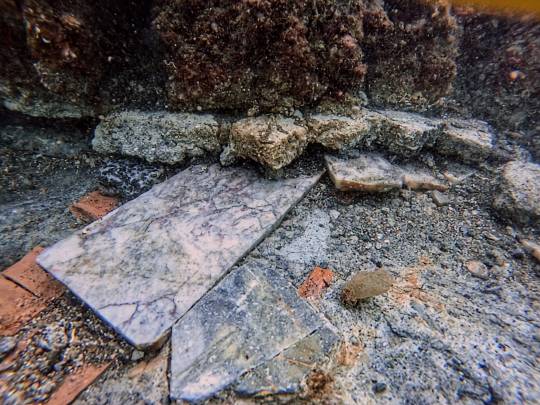
Researchers are working carefully to extract the marble pieces from the site, the park said. The recovery work will require careful digging around collapsed walls and other fragmented slabs, but researchers hope to "be able to save some of the geometries."
Once recovered, the slabs are being brought to land and cleaned in freshwater tanks. The marble pieces are then being studied "slab by slab" to try to recreate the former mosaic, the park said.
"The work is still long and complex, but we are sure that it will offer many prompts and great satisfactions," the park said.
By Kerry Breen
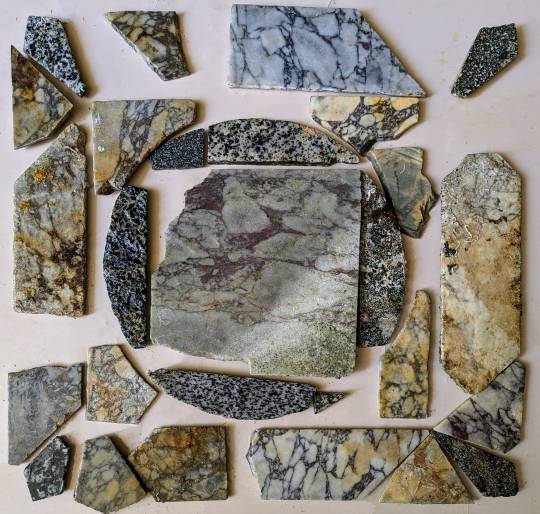

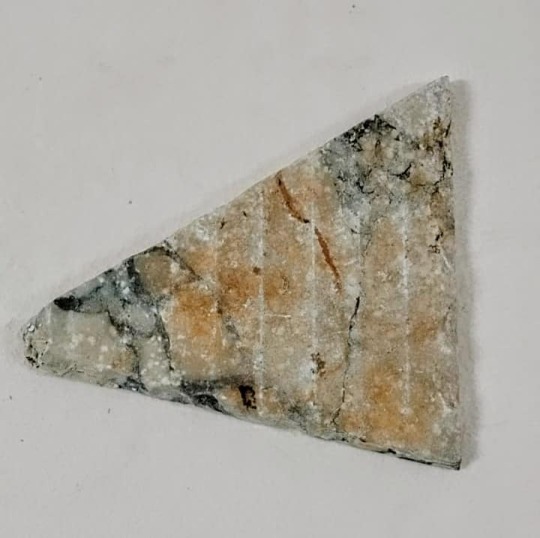
#Archaeologists Discover Ancient Roman Mosaic in Sea off Italy#Bay Sommersa#Roman city of Baia#The Campi Flegrei Archaeological Park#mosaic#ancient mosaic#ancient artifacts#archeology#archeolgst#history#history news#ancient history#ancient culture#ancient civilizations#roman history#roman empire#roman art#ancient art
530 notes
·
View notes
Text
fiber art adventures in egypt
I recently got back from a trip to Egypt & finally got around to organizing some pictures to share. One of the things I was most excited about was seeing what I could find on fiber arts and textiles.
Dropping everything under a read more, 'cause this will be a long post haha
first visit: the National Museum of Egyptian Civilization (NMEC)
At the time of visiting, they had a special textiles exhibit. It covered Pharonic Egypt all the way up to modern times, although I only had time to check out the dynastic & a bit of the Coptic portion of the exhibit (which was what I was really hoping to see anyways)
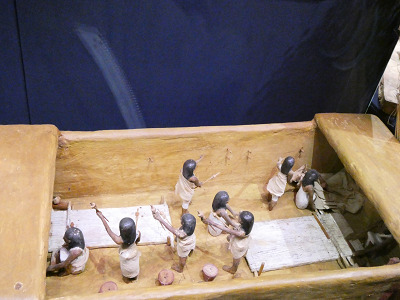
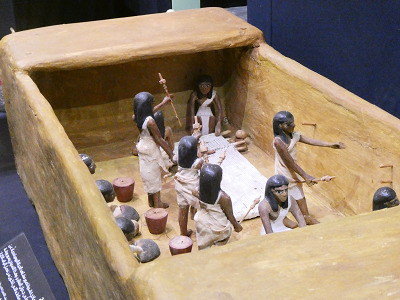
Was super excited to see this diorama in person. I knew about it but had never seen good pictures of it. From the little I've seen of ancient Egyptian spinning, spinning with two spindles seems to be the norm rather than a master technique? It also shows up in tomb art, which the exhibit also shared:

They also used a different fiber preparation (splicing to create a rove of fiber, no traditional drafting to my understanding) so that probably made a difference? Regardless I really want to see if I can replicate the technique, especially because their spindles look so similar to modern spindles??
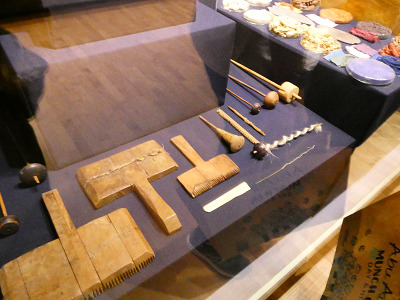
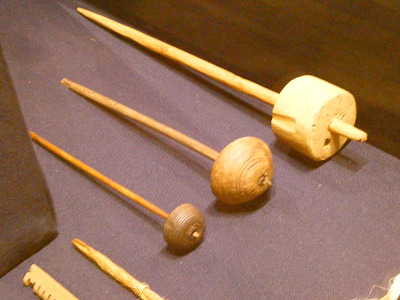
I took so many pictures of spindles, guys, and I fully intend to either have a few replicas made or to learn to make some myself. Also, although they were unlabeled... I'm pretty sure those are beaters for weaving? That was a bit of a trend with this trip, so much stuff was unlabeled :( I would've killed to at least get some date estimates for some of the stuff they had on display. I was nerding out in here though, and my family took a few pictures of how excited I was getting. A bit embarrassing, but eh haha
The exhibit also had a section on natural dyes used with a fun visual;
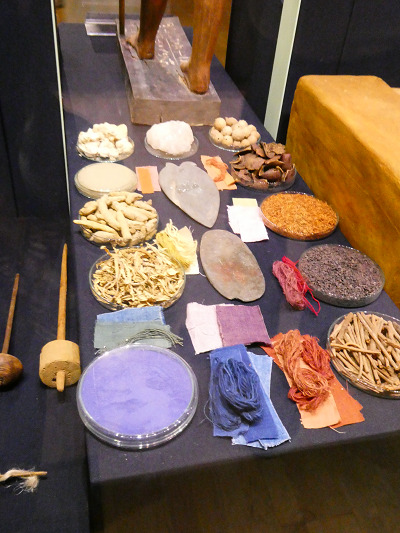
There was several diagrams specifically describing each dye source, but in the interest of not overloading on pictures I'll just list them out. For blues; woad, Yellows; turmeric, safflower, saffron, or yellow ochre; reds; madder, henna, pomegranate, and kermes. I originally thought kermes was another way to say cochineal, but it only seems to be distantly related.
next visit: Ramses Wissa Wassef Art Center
A small art center dedicated to hand-weaving wool and cotton tapestries. All of their work was museum quality & awe inspiring!!
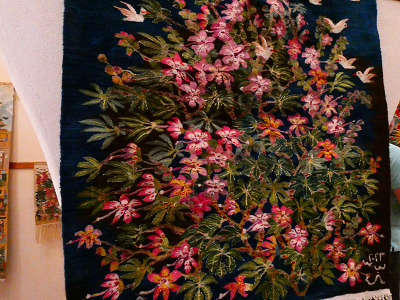
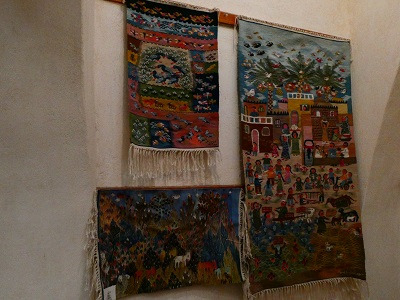

Was even invited to their back rooms to watch a few of their weavers working; no I don't have room to put a room-sized loom anywhere but heck do I want one now

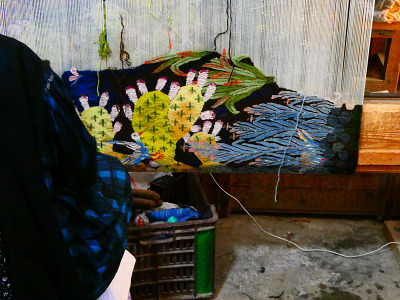
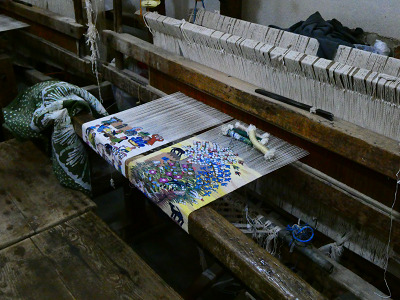
Our guide that took us through talked a bit about the natural dyes they use (all of their dyes are dyed in house with what they grow in their dye garden!!!) and got excited to hear I was also interested in natural dyes! He seemed a bit disappointed I'd never worked with indigo and. while indigo scares me, I'll take it as a sign that maybe I should try some time this year haha.
final visit; the Egyptian Museum
we really had to rush through this one which was a huge shame because it's packed full of artifacts. Also, the lighting in there is atrocious, so apologies for the not great pictures ahead.
They had a fascinating display of textile tools, more than what the NMEC had;

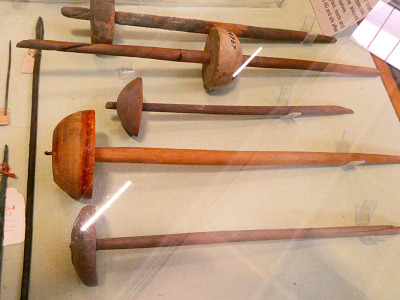

(Hand for size reference) I want all of these spindles! So badly! But a few of them look so much like a few of the spindles I own already?? A few of them had a spiraling notch, that's so cool? But also, what's going on with the one with two whorls? I have no idea. I'm fascinated.
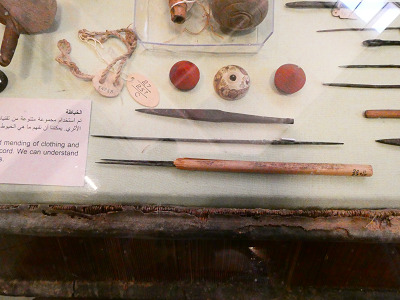

Look at these whorls!! Although again, I'm a bit confused; the lack of labeling strikes again. Unsure why some of these "whorls" have two holes, or what the metal object with the wooden handle is. The display implies sewing needles, and some of them do look like it, but others.... really don't look like sewing needles. I'm absolutely enchanted by this little whorl though. I think it has birds on it?
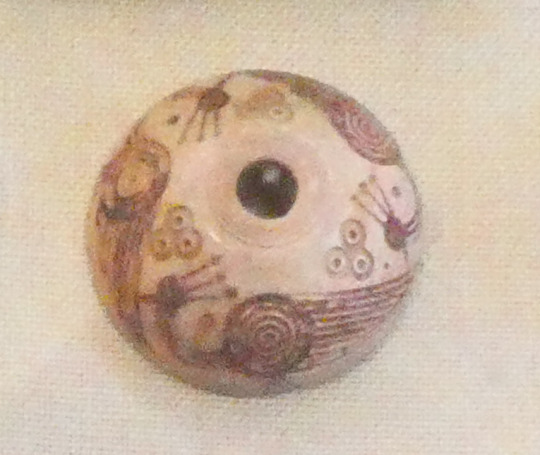

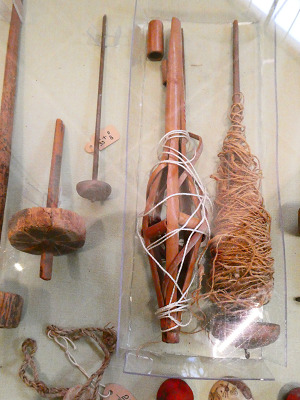
More objects that I'm baffled by- the signage doesn't really indicate what some of this stuff is, if it's even known. Also confused by the object wrapped in white string in the right pic; it looks like a distaff but to the best of my knowledge the (ancient at least) Egyptians didn't use distaffs. It probably popped up in later times and was put in this display since it was still relevant, but I'm still not sure.
I have so many more pictures & thoughts but I'll save those for more specific future projects. I've been doing research outside this trip on ancient Egyptian spinning techniques and desperately want to go deeper into that, this trip just solidified how excited it makes me. If you made it all the way through this, many thanks for reading!
Bonus; look at this ancient linen 🥺

#hand spinning#archaeology#extant artifact#weaving#fiber arts#long post#letters from skylark#sorry for the overall low quality images in this post. Got a new camera and wasn't the best at using it this trip#also the raw image files were huge so I heavily downsized them to make sure this post wasn't a beast to load#would be happy to share the raw images if desired though
279 notes
·
View notes